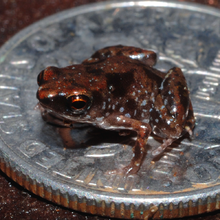Paedophryne amauensis
| Paedophryne amauensis | |
|---|---|
 |
|
| Paratype of Paedophryne amauensis (LSUMZ 95004) on a U.S. dime (diameter 18 mm) | |
| Scientific classification | |
| Kingdom: | Animalia |
| Phylum: | Chordata |
| Subphylum: | Vertebrata |
| Class: | Amphibia |
| Order: | Anura |
| Family: | Microhylidae |
| Subfamily: | Asterophryinae |
| Genus: | Paedophryne |
| Species: | P. amauensis |
| Binomial name | |
|
Paedophryne amauensis Rittmeyer et al. 2012 |
|
Paedophryne amauensis is a species of frog from Papua New Guinea discovered in August 2009 and formally described in January 2012. At 7.7 mm (0.30 in) in length, it is considered the world's smallest known vertebrate.
The newly described frog species was listed in the Top 10 New Species 2013 by the International Institute for Species Exploration for discoveries made during 2012. The list was announced on 22 May 2013.
The frog species was discovered in August 2009 by Louisiana State University herpetologist Christopher Austin and his PhD student Eric Rittmeyer while on an expedition to explore the biodiversity of Papua New Guinea. The new species was found near Amau village in the Central Province, from which its specific name is derived. The discovery was published in the peer-reviewed scientific journal PLoS ONE in January 2012.
Because the frogs have calls that resemble those made by insects and are camouflaged among leaves on the forest floor, Paedophryne amauensis were difficult to detect. While recording nocturnal frog calls in the forest, Austin and Rittmeyer used triangulation to identify the source of an unknown animal and discovered the frogs by scooping up handfuls of leaf litter and putting it into plastic bags where they spotted the tiny frog hopping around.
P. amauensis, attaining an average body size of only 7.7 millimetres (0.30 in), is 0.2 millimetres (0.0079 in) smaller than the previous record-holder as the world's smallest vertebrate, a species of cyprinid fish (Paedocypris progenetica; 7.9 mm [0.31 in]) from Indonesia. The frog lives on land and its life cycle does not include a tadpole stage. Instead, members of this species hatch as 'hoppers': miniatures of the adults. The skeleton is reduced and there are only seven presacral vertebrae present. They are capable of jumping thirty times their body length. The frog is crepuscular and feeds on small invertebrates. Males call for mates with a series of very high-pitched insect-like peeps at a frequency of 8400–9400 Hz.
...
Wikipedia
